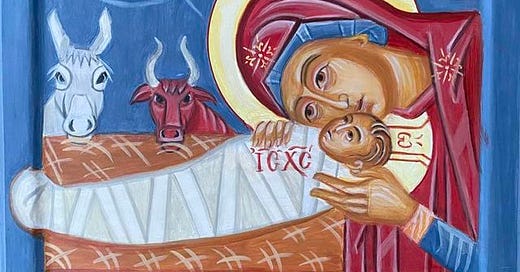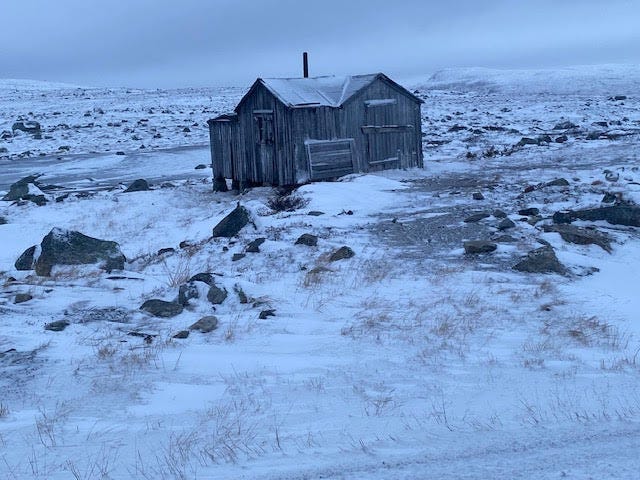A Christmas meditation
This year I have been looking for a newborn boy in a simple, small house. Whether animals also lived in this house is uncertain, but not improbable. Tradition has it that a donkey and an ox once found refuge in this house. They stood over their manger filled with straw and ruminated. For those who have ever observed a cow or other animal “ruminating” (which refers literally to chewing, swallowing, bringing the cud back up, and chewing some more), rumination can be compared to meditation: a slow, regular, repetitive movement. The straws of hay give a special sound as they are gnawed by the teeth. And then, when it is “eaten again,” the sound creates a slightly different melody. Rumination is a kind of contemplative music which inspires the soul to be quiet and content. I spent a lot of time with cows and sheep as I grew up. I remember how listening to the endless chewing instilled some kind of unity between me and the animals.
This brings me back to the familiar story of the newborn boy in the stable. Since there was no bed for him, the animals “offered” to let him rest in their crib. In this way creation united with its creator. On this evening, the animals were sharing the crib with that newborn boy who was their creator. The animals did not understand this mystery, of course. However, they meditated over it without knowing that it was what that they were doing. The same could be said about us humans who focus on spiritual matters.
The crib can also be seen as a symbol of an altar, a place where Jesus Christ sacrifices himself. The crib and the altar are, in turn, connected to the grave where the Lord would someday rest for three days. Instruments crafted by human hands became means of salvation.
We have a lot of knowledge about what happened that time around two thousand years ago. The boy's birthday is in midwinter, we hear. We are familiar with economic and social conditions, and in that way we can immerse ourselves in what life was like at that time. That it was cold at night is absolutely certain. The animals could provide some heat, but the most important source of heat was a simple fireplace on the floor.
This boy child keeps coming into the world, through the stories about him and his sacramental descent to earth. Perhaps he was born in the spring, but it is common to be invited to his birthday party in December. Some are annoyed when the annual invitation comes, while others come running like happy children to join the party.
I wondered if I was going to find the tiny house this year too. It would be a shame if I were to miss the highlight of the year. It is so easy to overlook such small houses and such small, newborn children. There is so much that can happen to the house and to the child. The young mother could fall ill from an infection… or pass out from fear that a launched rocket might hit the house. She hadn’t much time to prepare for the birth. They were on the run, and she knew they didn't have their papers in order. Now she handed it all over to God's protection and Joseph's safe hands.
Last November I was on a trip to eastern Norway. I was going to a birthday party for a friend who had just turned seventy. I chose to drive over Hardangervidda, which is a large plateau between the two regions — western and eastern — of Norway. The winter had set in, and the blowing snow made it difficult to see at times. Although I recently had changed to winter tires, the road was slippery in certain places, especially along the edges. If the speed was only slightly too high when taking a curve, the car would move forward and veer off the curve. This is a dangerous situation, and the need to adapt to physical laws becomes urgent.
The highest point on the road is 1000 meters above sea level, although the plateau itself is much higher. Several places along the way there are mounted protective shields against the snow drifts that build up. Of all the possible crossing routes between western and eastern Norway, Hardangervidda has the harshest conditions. During the winter, traffic is often closed, or the cars have to drive in a row with roadplows at both ends. Everything is white, except for the red brakelights of the automobiles in front of you. The challenge is to keep these lights in view without coming too close to the car ahead. If you no longer can see these lights, there’s great danger of an accident occurring. Three-meter-high wooden poles are placed on either side of the road so that the plows and cars can see where the road lies.
In this barren and freezing location, driving along slowly and steadily, I found myself searching for "Jesus' birth room," as the 18th-century Danish poet and bishop Hans Adolph Brorson puts it so beautifully. His birth room in reality is personal and secret. The individual soul must find the room for herself or himself, and move into it.
And then, suddenly, the house appeared just a few meters from the road. The ground was hard with frost and beyond the expanse lay scattered stones from the Ice Age. In other words, the environment here is much older than the story of Jesus' birth. The Lord was born two thousand years ago, while the rocks on Hardangervidda settled down eight thousand years ago. Time and space stands still here even today. Thus the story of salvation is both quiet and dynamic.
My heart will always wander
To where our Lord was born,
My thoughts will always go there
And take on their true form.
My longing does belong there,
With the treasure of my faith;
I never shall forget you,
O blessed Christmas night!





